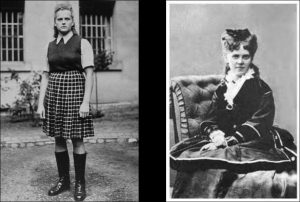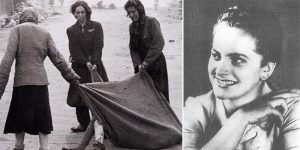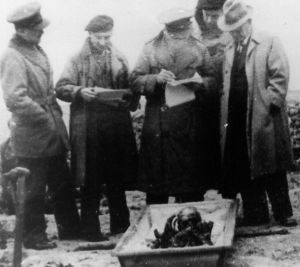Grese, Irma, was born on 07-10-1923 in Wrechen, to Alfred Grese, a dairy worker, and Berta Grese. Irma Grese was the third of five children. In 1936, her mother committed suicide by drinking hydrochloric after discovering that Alfred Grese had had an affair with a local pub owner’s daughter. Alfred Grese joined the Nazi Party
to Alfred Grese, a dairy worker, and Berta Grese. Irma Grese was the third of five children. In 1936, her mother committed suicide by drinking hydrochloric after discovering that Alfred Grese had had an affair with a local pub owner’s daughter. Alfred Grese joined the Nazi Party  in 19937, and remarried in 1939.
in 19937, and remarried in 1939. Grese left school in 1938 at the age of fourteen, owing to a combination of a poor scholastic aptitude, bullying by classmates, and a fanatical preoccupation with the Leaque of German Girls, Bund Deutscher Mädel, BDM, \
Grese left school in 1938 at the age of fourteen, owing to a combination of a poor scholastic aptitude, bullying by classmates, and a fanatical preoccupation with the Leaque of German Girls, Bund Deutscher Mädel, BDM, \

 a Nazi female youth organization, of which her father disapproved. Among other casual jobs, she worked as an assistant nurse in the sanatorium of the SS for two years and unsuccessfully tried to find an apprenticeship as a nurse.
a Nazi female youth organization, of which her father disapproved. Among other casual jobs, she worked as an assistant nurse in the sanatorium of the SS for two years and unsuccessfully tried to find an apprenticeship as a nurse.
Grese worked as a dairy helper and was single when she volunteered for service in a concentration camp. From mid-1942 she was Aufseherin, a female quard at Ravensbrück and in March 1943 transferred to Auschwitz-Birkenau. In the second half of 1944, Grese was promoted to Rapportführerin, the second-highest rank open to female KZ-wardens. In this function, she participated in prisoner selections for the gas chambers. Of the 37,000 SS guards who actively participated in the daily suffering, torture and death of the internees, approximately 10 per cent were female overseers.
In early 1945, Grese  accompanied a prisoner transport from Auschwitz to Ravensbrück. In March 1945, she went to Bergen-Belsen along with a large number of prisoners from Ravensbrück. Grese was captured by the British on 17-04-1945, together with other SS personnel who did not flee. Grese inspired virulent hatred in prisoner Olga Lengyel,
accompanied a prisoner transport from Auschwitz to Ravensbrück. In March 1945, she went to Bergen-Belsen along with a large number of prisoners from Ravensbrück. Grese was captured by the British on 17-04-1945, together with other SS personnel who did not flee. Grese inspired virulent hatred in prisoner Olga Lengyel, 
 who in her memoir, Five Chimneys, wrote that selections in the women’s camp were made by SS Aufseherin Elisabeth Hasse
who in her memoir, Five Chimneys, wrote that selections in the women’s camp were made by SS Aufseherin Elisabeth Hasse  and Irma Grese. Olga Lengyel survived the war and died died on 15-04-2001 at the age of 92. Her two sons and parents died in the gas chamber. She was the only member of her family to survive. She wrote a book about her life in a concentration camp
and Irma Grese. Olga Lengyel survived the war and died died on 15-04-2001 at the age of 92. Her two sons and parents died in the gas chamber. She was the only member of her family to survive. She wrote a book about her life in a concentration camp  The latter was visibly pleased by the terror her presence inspired in the women at roll call. She had a penchant for selecting not only the sick and the weak but any woman who had retained vestiges of her former beauty. Her nickname was “The Beautifll Beast” but also “The Hyena of Auschwitz”. Lengyel said that Grese had several lovers among the SS in the camp, including Josef Mengele in Block 10
The latter was visibly pleased by the terror her presence inspired in the women at roll call. She had a penchant for selecting not only the sick and the weak but any woman who had retained vestiges of her former beauty. Her nickname was “The Beautifll Beast” but also “The Hyena of Auschwitz”. Lengyel said that Grese had several lovers among the SS in the camp, including Josef Mengele in Block 10


 After Grese forced the inmate surgeon at the infirmary into performing her illegal abortion, she disclosed that she planned a career in the movies after the war. Lengyel felt that Grese’s meticulous grooming, custom fitted clothes, and overuse of perfume were part of a deliberate act of sadism among the ragged women prisoners.
After Grese forced the inmate surgeon at the infirmary into performing her illegal abortion, she disclosed that she planned a career in the movies after the war. Lengyel felt that Grese’s meticulous grooming, custom fitted clothes, and overuse of perfume were part of a deliberate act of sadism among the ragged women prisoners.

When the British arrived at the Belsen camp, Irma Grese was standing at the gate into the camp, along with the Belsen Commandant Josef Kramer,  offering her help. was married with a schoolteacher, Rosina Kramer
offering her help. was married with a schoolteacher, Rosina Kramer  Most of the Belsen guards had run away before the British arrived, but not the brave German girl, Irma Grese, who took her life in her hands to help the British during a typhus epidemic. To her surprise, Irma was immediately arrested by the British, and a few months later, she was put on trial as a war criminal. Josef Kramer was also arrested and put into a dark prison cell.
Most of the Belsen guards had run away before the British arrived, but not the brave German girl, Irma Grese, who took her life in her hands to help the British during a typhus epidemic. To her surprise, Irma was immediately arrested by the British, and a few months later, she was put on trial as a war criminal. Josef Kramer was also arrested and put into a dark prison cell.


Grese was among the 45 people accused of war crimes at the Belsen Trial. She was tried over the first period of the trials and was represented by Major L. Cranfield.
The trials were conducted under British military law in Lüneburg, and the charges derived from the Geneva Convention of 1929 regarding the treatment of prisoners. The accusations against her centred on her ill-treatment and murder of those imprisoned at the camps. Survivors provided detailed testimony of murders, tortures, and other cruelties, especially towards women, in which Grese engaged during her years at Auschwitz and at Bergen-Belsen. They testified to acts of sadism, beatings and arbitrary shootings of prisoners, savaging of prisoners by her trained and allegedly half-starved dogs, and to her selecting prisoners for the gas chambers. Grese was reported to have habitually worn heavy boots and carried a whip and a pistol. Witnesses testified that she took pleasure in using both physical and psychological methods to torture the camp’s inmates and enjoyed shooting prisoners in cold blood. They also claimed that she beat some women to death and whipped others using a plaited whip.
Irma Grese’s testimony, under direct examination, about her background
:

I was born on 07-10-1923. In 1938 I left the elementary school and worked for six months on agricultural jobs at a farm, after which I worked in a shop in Lychen for six months. When I was 15 I went to a hospital in Hohenlychen, where I stayed for two years. I tried to become a nurse but the Labour Exchange would not allow that and sent me to work in a dairy in Fürstenberg. In July, 1942, I tried again to become a nurse, but the Labour Exchange sent me to Ravensbrück Concentration Camp, although I protested against it. I stayed there until March, 1943, when I went to Birkenau Camp in Auschwitz. I remained in Auschwitz until January, 1945.
Death and burial ground of Grese, Irma, Ida Ilse “The Beautiful Beast”.



 During the trial, the press labelled Grese as “the Beautiful Beast” alongside Kramer (“the Beast of Belsen”). Although the charges against some of the other female wardens (a total of 16 were charged) were as serious as those against Grese, she was one of only three female guards to be sentenced to death.
During the trial, the press labelled Grese as “the Beautiful Beast” alongside Kramer (“the Beast of Belsen”). Although the charges against some of the other female wardens (a total of 16 were charged) were as serious as those against Grese, she was one of only three female guards to be sentenced to death.
After a fifty-three day trial, Grese was sentenced to death by hanging. On Thursday, 13-12-1945, in Hameln Jail , Grese was led to the gallows. The women were executed singly by long-drop hanging and then the men in pairs. The army hangman Ronald Cook refused to hang Grese. Major Gerome Burdik ordered him to and that night Cook went home and shot himself. Regimental Sergeant-Major O’Neil assisted the noted British executioner, Albert Pierrepoint:



We climbed the stairs to the cells where the condemned were waiting. A German officer at the door leading to the corridor flung open the door and we filed past the row of faces and into the execution chamber. The officers stood at attention. Brigadier Paton-Walsh stood with his wristwatch raised. He gave me the signal, and a sigh of released breath was audible in the chamber, I walked into the corridor. ‘Irma Grese’, I called. The German guards quickly closed all grilles on twelve of the inspection holes and opened one door. Irma Grese stepped out. The cell was far too small for me to go inside , and I had to pinion her in the corridor. ‘Follow me,’ I said in English, and O’Neil repeated the order in German. At 9.34 a.m. she walked into the execution chamber, gazed for a moment at the officials standing round it, then walked on to the centre of the trap, where I had made a chalk mark. She stood on this mark very firmly, and as I placed the white cap over her head she said in her languid voice, ‘Schnell’, ‘Quickly.’ The drop crashed down, and the doctor followed me into the pit and pronounced her dead. After twenty minutes the body was taken down and placed in a coffin ready for burial. The British judge, Major General Horatio Pettus Mackintosh Berney-Ficklin
The German guards quickly closed all grilles on twelve of the inspection holes and opened one door. Irma Grese stepped out. The cell was far too small for me to go inside , and I had to pinion her in the corridor. ‘Follow me,’ I said in English, and O’Neil repeated the order in German. At 9.34 a.m. she walked into the execution chamber, gazed for a moment at the officials standing round it, then walked on to the centre of the trap, where I had made a chalk mark. She stood on this mark very firmly, and as I placed the white cap over her head she said in her languid voice, ‘Schnell’, ‘Quickly.’ The drop crashed down, and the doctor followed me into the pit and pronounced her dead. After twenty minutes the body was taken down and placed in a coffin ready for burial. The British judge, Major General Horatio Pettus Mackintosh Berney-Ficklin  who feared German martyrdom, ordered that Irma and the other hanged were buried in the Hamelin prison yard.
who feared German martyrdom, ordered that Irma and the other hanged were buried in the Hamelin prison yard.  Berney-Ficklin died age 68 on 17-02-1961 in Cape Town. In 1954 Irma Grese is reburied in holy ground at Am Wehl Cemetery. The graveyard had graves with crosses but after many discussions about the Neo Nazi visits, on 05-03-1986 all 200 Iron Crosses were removed and the graveside is now a grass field.
Berney-Ficklin died age 68 on 17-02-1961 in Cape Town. In 1954 Irma Grese is reburied in holy ground at Am Wehl Cemetery. The graveyard had graves with crosses but after many discussions about the Neo Nazi visits, on 05-03-1986 all 200 Iron Crosses were removed and the graveside is now a grass field.




Foto van August 2019.

Message(s) for the webmaster, tips or interesting graves: robhopmans@outlook.com

















Ricardo
Do I figure out where Irma grese is buried ?
Ricardo
I would like to know the exact location where Irmgard grese is buried, in which part and exact place of the lawn. It’s possible to know ?
brenner
in an unmarked now.
Rob Hopmans
Good Day,
Sorry for not responding sooner and I am a 77 year old ww2 interested who struggles to keep this ww2 interest website up and running. and get so many enthusiastic thanks emails a day that I can’t answer them all immediately and I also have a disabled woman who is now in an unpleasant situation.
Can use any support but you see what you do with it. Greetings and stay healthy.
Robert Hopmans
Judith
Hi- Irma Grese was not standing at the gates to help. She was standing and hitting prisoners who were trying to escape. She was one of the most cruel people to ever work in a prison camp – and that is saying a lot. She was even disciplined by the SS for her cruelty to prisoners. And one of the photos you have up is not Grese – though it is often mistaken for her (over the words “inspection holes”). It’s an actress from an old movie.